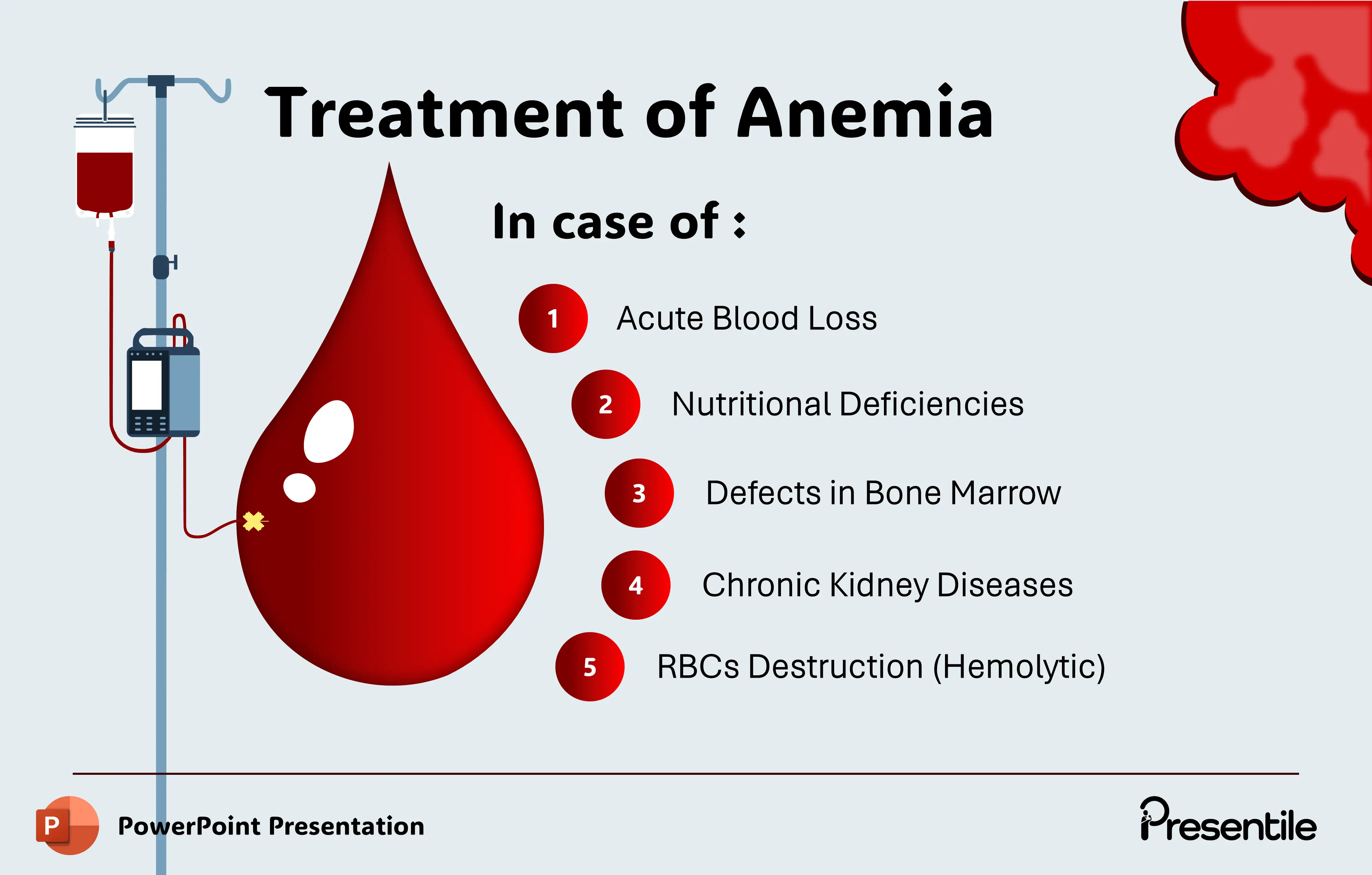
Content of
Management of Anemia PowerPoint Presentation
Slide 1: Management of anemia cover slide

- In this presentation you will get to know more about the management of anemia
- The design elements are thoughtfully chosen to convey key aspects of anemia treatment.
- This slide would serve as an effective opener for a comprehensive presentation on anemia management protocols and treatment strategies.
Slide 2: Presentation of anemia section slide

- Anemia is a common condition with significant impacts on overall health, so prevention strategies are critical to reducing its prevalence and consequences.
- The compelling visual design features a protective shield alongside a blood drop, emphasizing the importance of proactive health measures in maintaining healthy blood levels.
Slide 3: Prevention of anemia

- Taking a daily multivitamin can help ensure individuals meet their essential micronutrient requirements for prevention of anemia.
- A balanced diet rich in iron and vitamin B12 is important. Including food like red meat, poultry, and fish, eggs, dairy, and seafood. Iron play a key role in hemoglobin production
- Folic acid is another essential nutrient for anemia prevention. Leafy greens, citrus fruits, lentils, and fortified cereals are excellent sources of folic acid. Regular screening such as blood test help to prevent anemia, enabling early detection especially for at-risk populations.
- These strategies are visually represented with clear icons showing vitamins, healthy foods, and medical checkups, while the protective shield symbol with red blood cells on the right reinforces how these preventive measures work together to maintain healthy blood levels and prevent anemia development.
Slide 4: Treatment of anemia

- This section slide introduces the treatment section of the management of anemia presentation.
- Featuring a visual of a large red blood drop connected to an IV stand and blood transfusion equipment.
Slide 5: Example of treatment of anemia in different cases

- There are different treatments for different cases of anemia, for example, in the case of: Acute Blood Loss, Nutritional Deficiencies, Defects in Bone Marrow, Chronic Kidney Diseases, and RBCs destruction known as haemolytic.
- This slide uses an illustrate a Blood drop with red points to label the different tratments
Slide 6: Acute blood loss anemia treatment: different approaches

- Acute blood loss anemia is a condition that requires immediate intervention. Key strategies for managing acute blood loss anemia include administering intravenous fluids to maintain blood volume and prevent shock. Crossmatched packed red blood cells are transfused to restore hemoglobin levels and the oxygen-carrying capacity of the blood. Crossmatching ensures that the blood products are compatible with the patient’s blood type. Oxygen therapy improves oxygen delivery to tissues during acute blood loss by administering supplemental oxygen. Another key component of treatment is establishing at least two large-bore intravenous lines for the rapid and efficient administration of fluids, blood products, and medications.
- The slide's design effectively communicates the urgency of these treatments through a medical cross symbol within a hand showing blood loss, while the numbered treatment steps along a vertical timeline reinforces the sequential nature of the interventions.
Slide 7: Blood transfusion steps as treatment of acute blood Loss anemia

- Blood transfusions replace blood that is lost through surgery or injury, or they provide blood if the body is not making it properly.
- After a doctor determines that the patient needs a blood transfusion, the patient will be tested to ensure the blood given is a good match. Blood transfusions usually take 1 to 4 hours to complete. The patient will be monitored during and after the procedure.
- The process is illustrated with clear medical visuals showing an IV setup and simplified icons representing each step of the transfusion process.
Slide 8 : Risks and complications of blood transfusion

- Blood transfusion is an important treatment for Acute Blood Loss Anemia, healthcare providers must be aware of several potential risks and complications.
- These include allergic reactions ranging from mild to severe; serious complications such as fever and potential heart or lung problems; iron overload which may result in iron buildup in the body; and the possibility, though rare with modern screening, of contracting infectious diseases such as hepatitis B, C, or HIV.
- The slide illustrates these risks with clear medical icons alongside an IV administration setup, emphasizing the importance of careful monitoring and risk assessment during transfusion procedures.
Slide 9 : Nutritional deficiencies anemia treatment

- The treatment approach for Nutritional Deficiencies Anemia is tackled by taking dietary supplements.
- Dietary supplements are recommended to address overall nutritional gaps, featuring vitamin B12 supplementation, available in both oral supplement form and as injections for those with absorption issues, and Iron supplementation is emphasized as an Important component, available in both oral and injectable forms.
- The slide visually represents these treatments alongside common sources of vitamins such as fresh fruits and milk, demonstrating a comprehensive approach to addressing nutritional anemia through both supplements and dietary sources.
Slide 10: Oral iron supplements best practice for anemia treatment

- When prescribing oral iron supplementation for Nutritional Deficiencies Anemia, healthcare providers consider four key factors in determining the appropriate dose.
- These factors include the patient's age, which influences dosing requirements; the severity of iron deficit, which helps determine the supplementation amount needed; the correction rate; and side effect tolerance, as some patients may experience varying degrees of digestive system reactions to iron supplements.
- The slide illustrates these considerations alongside an iron supplement bottle and a hand holding a supplement capsule, emphasizing the importance of personalised treatment dosing for oral iron therapy.
Slide 11: Oral iron side effects

- This slide mentions common Oral iron side effects that may occur during iron deficiency treatment.
- Three primary side effects are typically observed: metallic taste in the mouth, which can affect the patient's sense of taste; constipation, which is a common digestive system response to iron supplementation; and black tarry stools, which is a normal discoloration caused by the iron supplements.
- The slide presents these side effects with clear icons alongside an iron supplement bottle illustration, helping healthcare providers effectively communicate potential effects to patients.
Slide 12: Intravenous iron as a nutritional deficiency anemia treatment

- This slide is about intravenous iron treatment. Intravenous (IV) iron therapy is specifically indicated for two key situations in Nutritional Deficiencies Anemia treatment.
- First, it's recommended for patients who demonstrate intolerance to oral iron supplements, which may make traditional supplementation impractical.
- Second, IV iron is used when rapid repletion of iron stores is necessary, allowing for faster correction of iron deficiency compared to oral administration.
- The slide illustrates these indications alongside an IV iron bag marked with 'Fe' (the chemical symbol for iron) and a receiving arm, depicting the direct delivery method of this treatment approach.
Slide 13: Types of treatments in case of bone marrow defects anemia

- This slide illustrates the concept of a bone marrow transplant, also known as a hematopoietic stem cell transplant, as a treatment for anemia.
- It highlights two main types of transplants: Autologous, where the patient receives their own stem cells collected earlier, and Allogeneic, where stem cells are donated by a compatible individual.
- The process involves replacing faulty blood-forming stem cells with healthy ones, aiming to restore normal blood cell production and alleviate anemia symptoms.
Slide 14: The process of the bone marrow transplant as anemia treatment

- The key stages involved in a bone marrow transplant, a treatment for anemia.
- The process begins with a preparation phase, typically lasting two weeks.
- This is followed by the actual transplant procedure, where healthy stem cells are introduced into the patient's bloodstream.
- Post-transplant, the patient undergoes a monitoring phase to assess engraftment and manage potential complications.
- Throughout the process, infection prevention measures are crucial to minimizing risks.
Slide 15: Potential complications of bone marrow transplant medication side effects

- This slide highlights potential complications associated with bone marrow transplantation as a treatment for anemia.
- The side effects of medications commonly used in this procedure, including vomiting, diarrhea, hair loss, and liver damage.
- These complications should be carefully considered and discussed with patients undergoing bone marrow transplantation to manage expectations and optimize treatment outcomes.
Slide 16: Potential Complications of bone marrow transplant: weakened immune system

- This slide highlights a significant complication of bone marrow transplantation for anemia: a weakened immune system.
- The destruction of the patient's existing bone marrow and the time it takes for transplanted stem cells to engraft and produce new immune cells leave the patient highly susceptible to infections.
- This increased risk of infection is a critical concern during the post-transplant period and necessitates rigorous infection prevention measures.
Slide 17: Potential complications of bone marrow transplant: Graft-versus-host disease

- This slide focuses on Graft-versus-host Disease (GVHD), a serious complication that can occur after bone marrow transplantation for anemia.
- GVHD arises when the donated stem cells recognize the recipient's tissues as foreign and attack them.
- This immune reaction can cause a range of symptoms affecting multiple organs and can have significant morbidity and mortality.
Slide 18: Potential complications of bone marrow transplant: steam cell rejection

- This slide focuses on stem cell rejection, a potential complication following bone marrow transplantation for anemia.
- The recipient's body may fail to accept the donated stem cells, hindering their engraftment and ability to produce healthy blood cells.
- This complication is more common in allogeneic transplants and can be managed with supportive care and growth factors to stimulate stem cell growth or even doing a second transplant.
Slide 19: Chronic kidney disease anemia treatment

- This slide illustrates erythropoietin therapy, a treatment option for anemia associated with chronic kidney disease.
- Erythropoietin is a hormone naturally produced by the kidneys that stimulates red blood cell production in the bone marrow.
- In patients with chronic kidney disease, erythropoietin levels decrease, leading to anemia.
- Erythropoietin therapy involves administering synthetic erythropoietin (ESAs) to stimulate red blood cell production and improve anemia-related symptoms.
Slide 20: Hemolytic anemia treatment

- This slide outlines treatment options for hemolytic anemia, a condition characterized by the premature destruction of red blood cells.
- Treatments can include mechanical valve replacement in cases of heart valve-related hemolysis, discontinuation of medications causing drug-induced hemolysis, and splenectomy (removal of the spleen) to reduce red blood cell destruction in certain autoimmune hemolytic anemias.
Slide 21: Closing thank you slide (anemia themed)
.webp)
- This slide serves as a closing slide with thank you title.
- The image of a blood drop symbolizes the focus of the presentation and reinforces the importance of understanding and managing anemia in clinical practice.
Features of
Management of Anemia PowerPoint Presentation
- Fully editable in PowerPoint
- All graphics are in vector format
- Medically Referenced information and data
Management of Anemia PowerPoint Presentation
Management of Anemia PowerPoint Presentation
Price:
$ 59.00 USD
Specifications
 Slides count:
Slides count: Compatible with:Microsoft PowerPoint
Compatible with:Microsoft PowerPoint File type:PPTX
File type:PPTX Dimensions:16:9
Dimensions:16:9
Files Included
 Non-animated PowerPoint
Non-animated PowerPoint Animated PowerPoint File
Animated PowerPoint File Animated PowerPoint with Voice Over
Animated PowerPoint with Voice Over PDF Documents with presentation script
PDF Documents with presentation script
Elevate Your Work with Our Innovative Slides
Thank you! Your submission has been received!
Oops! Something went wrong while submitting the form.




















